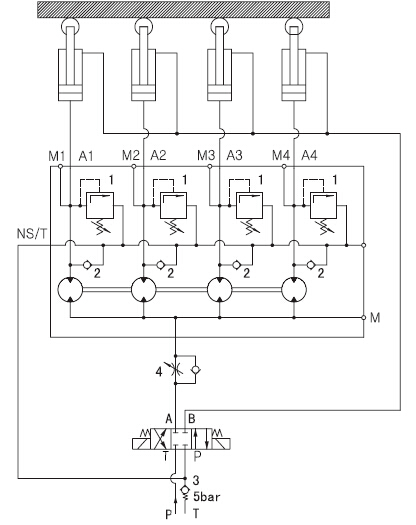During the use of a synchronous hydraulic motor, problems occur when the motor is out of sync or the synchronization accuracy does not meet the control requirements. How to solve these problems? And see how Dalan Hydraulics analyzes.
During the use of a synchronous hydraulic motor, problems occur when the motor is out of sync or the synchronization accuracy does not meet the control requirements. How to solve these problems? And see how Dalan Hydraulics analyzes.
First of all, we need to understand the control principle of the synchronous hydraulic motor. The following figure is a schematic diagram of a four-way synchronous hydraulic motor control.

1 The relief valve 1 corresponds to a safety valve: it prevents excessive pressure from being generated at the outlet of the
Hydraulic Cylinder due to pressure amplification. Due to the setting of this valve, even if one hydraulic cylinder in the circuit has completed the entire stroke ahead of time, the other hydraulic cylinders can continue to rise until all the hydraulic cylinders complete the working stroke;
The function of the two-way valves 2 and 3 is to ensure that the chamber of each chamber of the synchronous motor can maintain a minimum pressure of about 4 bar, and the opening pressure of the valve 2 is about 1 bar, so that the opening pressure of the valve 3 is about 5 bar. It is very important to ensure the minimum pressure of the system. When one of the hydraulic cylinders has completed its working stroke, the synchronous motor is still providing power for other slower hydraulic cylinders. At this time, the minimum pressure of the system can guarantee the speed. Fast hydraulic cylinders do not absorb air;
3 The role of the one-way throttle valve 4 is also very important. In addition to adjusting the rising speed of the hydraulic cylinder, a certain back pressure can also be generated when descending. When the hydraulic cylinder is lowered, the task of the synchronous motor is to collect the oil return of the hydraulic cylinder and ensure the flow rate is consistent. At this time, the function of the valve 4 is to prevent the synchronous motor from operating at the speed of the fastest hydraulic cylinder, resulting in other slightly slower hydraulic cylinders. Keep up with it, of course, when all hydraulic cylinders are running at the same speed, the synchronous motor only acts as a collector.
4 The function of the throttle valve 4 can also be replaced by an overflow valve or a balancing valve, and the action of the valve 4 is particularly important when there is a load on the return stroke of the hydraulic cylinder.
Secondly, it analyzes the cause of the error of the synchronous hydraulic motor. Whether it is a plunger type or a gear type synchronous hydraulic motor, the cause of the synchronization error is mainly reflected in the following points:
1 machining accuracy of hydraulic synchronous motor and hydraulic actuator;
2 the uniformity of the load of the hydraulic actuator and the continuity of the action;
3 the content of gas in the hydraulic oil;
4 hydraulic pipe layout.
----- Editor-in-Chief: Dalan Oil Pump Motor 02-Procurement Consultant
Copyright http: / (Dalan Motor) Reprint, please indicate the source
Http://news.chinawj.com.cn Editor: (Hardware Business Network Information Center) http://news.chinawj.com.cn



